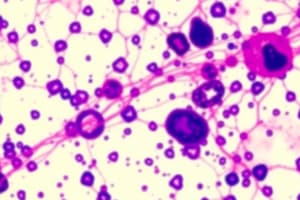Podcast
Questions and Answers
What are the two purposes of heat fixation?
What are the two purposes of heat fixation?
- The bacteria can be fixed to the slide. 2. Heat fixation is a way to kill bacteria without destroying them.
What is the purpose of simple staining?
What is the purpose of simple staining?
To create a contrast between the bacteria and the background.
Why are basic dyes more successful in staining bacteria than acidic dyes?
Why are basic dyes more successful in staining bacteria than acidic dyes?
Basic dyes have a positively charged chromogen that forms an ionic bond with negatively charged bacterial cells, allowing them to be colored. Acidic dyes are repelled by bacterial cells and only color the background.
Why is time an important factor in simple staining?
Why is time an important factor in simple staining?
How would you define a properly prepared bacterial smear?
How would you define a properly prepared bacterial smear?
Flashcards are hidden until you start studying
Study Notes
Heat Fixation
- Heat fixation allows bacteria to adhere to the slide, preventing them from washing away during subsequent staining processes.
- This method effectively kills the bacteria while maintaining their structural integrity for observation.
Purpose of Simple Staining
- Simple staining enhances contrast between bacteria and their background, making cells more visible under a microscope.
Basic vs. Acidic Dyes
- Basic dyes possess a positively charged chromogen that binds to negatively charged bacterial cells, allowing direct visualization of the cell.
- Acidic dyes contain a negatively charged chromogen, which is repelled by bacterial cells, resulting in a colored background and transparent bacteria, allowing for indirect observation.
- Basic dyes are generally more effective in staining bacteria than acidic dyes due to the ionic bond formed.
Importance of Timing in Staining
- Proper timing during the staining process is crucial to avoid false reactions.
- Overstaining can lead to excessive darkness in bacteria, hindering differentiation.
- Understaining can result in bacteria appearing too light, making them hard to discern.
Properly Prepared Bacterial Smear
- A suitable smear features evenly dispersed bacteria in a concentration that allows adequate separation for clear observation.
- The bacteria must remain adhered to the slide, preventing them from being washed away during the staining process.
- The microscopic form of the bacteria should remain undistorted to ensure accurate analysis.
Studying That Suits You
Use AI to generate personalized quizzes and flashcards to suit your learning preferences.




